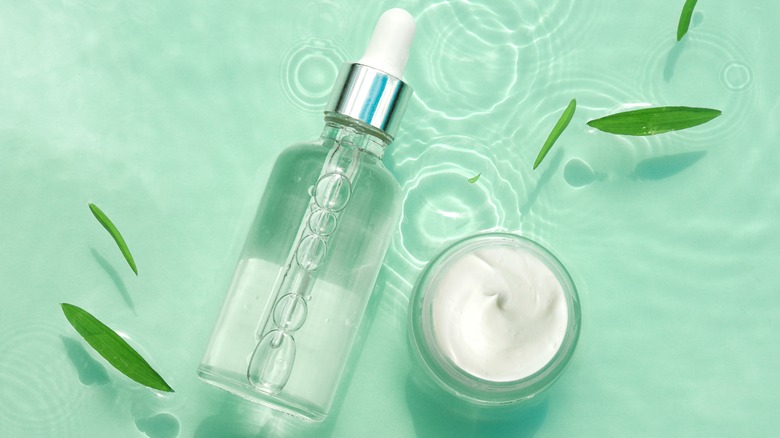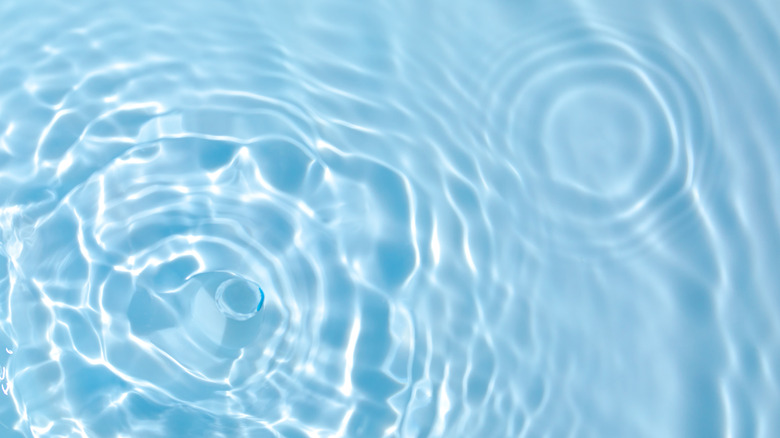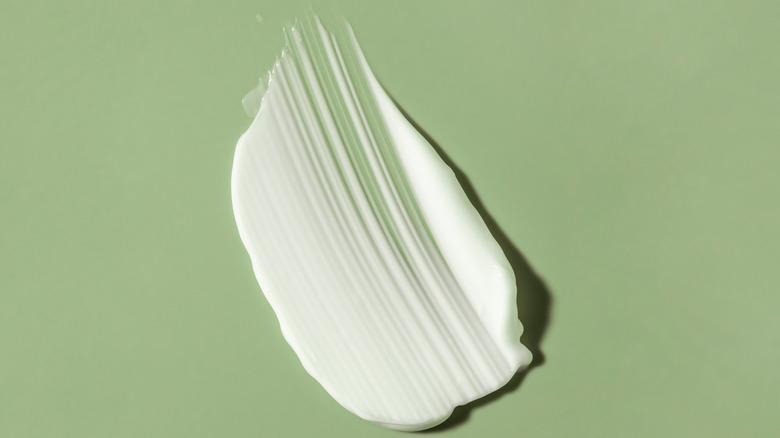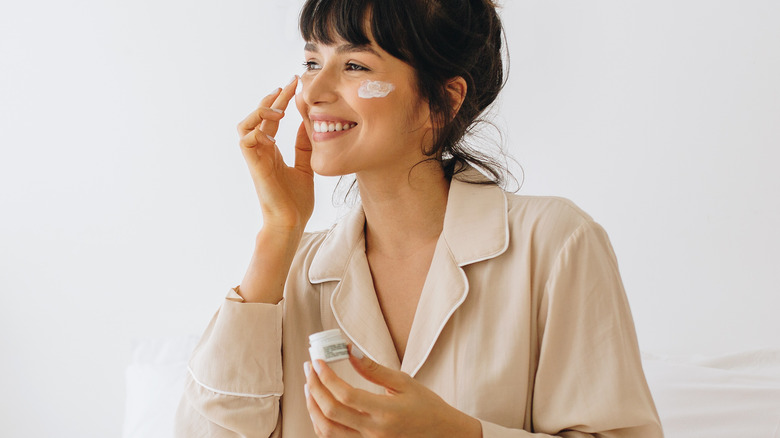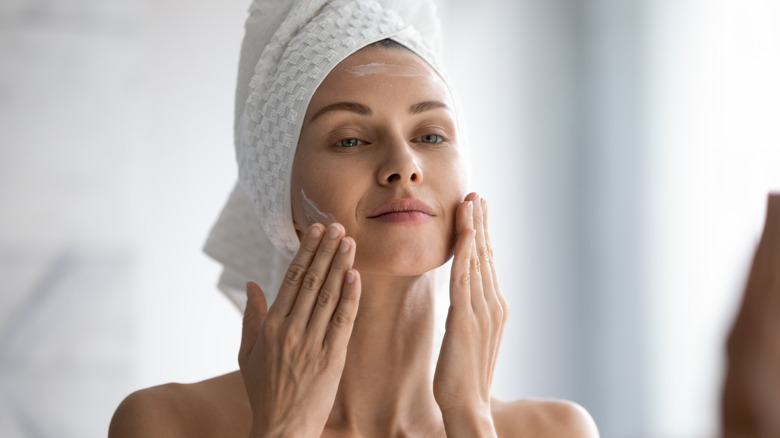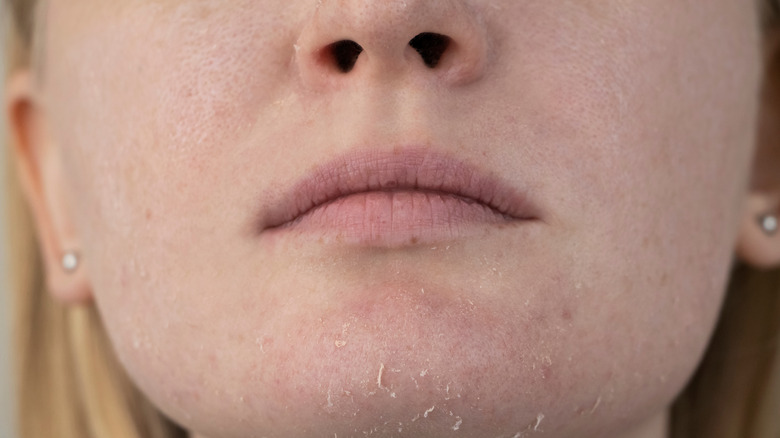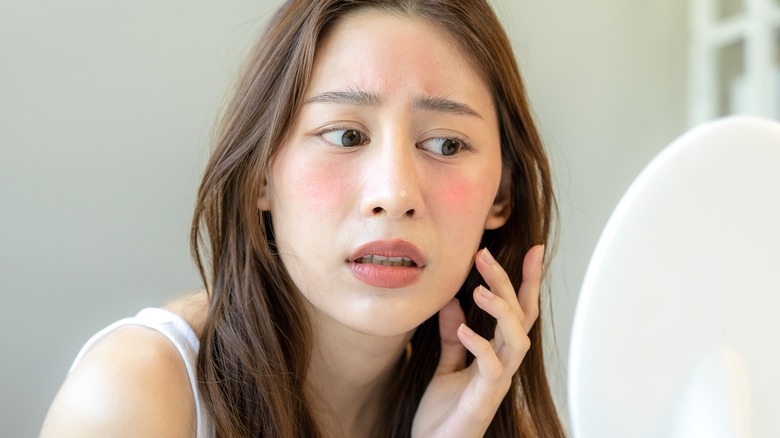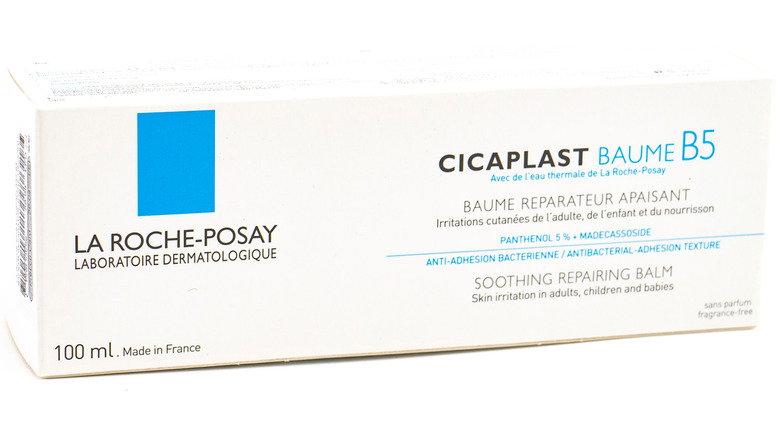Humectant Vs. Emollient: What's The Difference?
We may receive a commission on purchases made from links.
The skincare world can be as basic or as extravagant as you want it to be. Some people just wash their face, add a little moisturizer, and are ready to go, while some prefer more extensive methods, such as the 10-step Korean skincare routine with an array of serums, eye creams, and face masks. Whichever category you fall under, one step always includes moisturizing your face.
In fact, Dr. Peter Schmid, plastic surgeon and SkinCeuticals ambassador, told Skincare.com, "Moisturizer is simply a generic term encompassing an extensive array of topical creams, gels, lotions, emulsions, and ointments." Moisturizers typically contain three kinds of ingredients called humectants, emollients, and occlusives for their specific benefits.
How does a moisturizer help the skin? According to Healthline, moisturizers help "increase the water content in the stratum corneum, the skin's outermost layer, which relieves dryness." A well-hydrated face feels softer and looks healthier, and moisturizers can also help combat signs of aging. Moreover, Temitayo A. Ogunleye, M.D., told SELF a moisturizer "'seals' in the cracks between your skin and allows you to retain moisture for longer." Humectants and emollients perform very different functions though they sound very similar, and sometimes, an ingredient can be both a humectant and an emollient. But what makes them different?
What is a humectant?
If you are on top of the skincare game, you must have heard of hyaluronic acid. It's everywhere nowadays, from serums to moisturizers. Hyaluronic acid and glycerin are two of the most popular humectants used in skincare products (via Skincare.com). According to WebMD, humectants are ingredients that "attract water from the air or from deeper in the skin," so they're commonly used in skincare products to hydrate the skin and make it look plumper. They are a great help for dry skin because they can draw water from the surroundings if you are in a humid climate.
However, you have to be careful because if you use it in a dry environment, it will attract moisture from the "deeper layers of the dermis into the stratum corneum," making your skin drier, per Mind Body Green. It is best to apply a humectant on damp skin and add a moisturizing cream on top, so it doesn't evaporate or dry your skin even more, which is why Azadeh Shirazi, M.D., told Byrdie, "Humectants can be dry skin's BFF or worst enemy."
What is an emollient?
Facial oils are having a big moment, and most of them are emollients. If you are prone to dry skin, it probably feels rough and tight, and that is because your skin lacks moisture. Many ingredients fall under the category of emollients, like rich kinds of butters and oils (via Byrdie). New York City-based dermatologist Marnie Nussbaum told the outlet, "When skin is dry and flaky, there are open spaces in your skin cells. An emollient can help to fill those spaces and smooth out the skin." They also do a fantastic job of strengthening the skin barrier and keeping your skin healthy.
Dry skin can feel rough, but what you need to know about emollients is that they're ingredients that soften your skin (via Healthline). They are beneficial if you have skin conditions like eczema or psoriasis to heal and soothe you. In general, using emollients makes your skin smoother and softer, and everyone can use them because they don't have any side effects. Still, you might want to consider your skin type to choose the most suitable emollient. Soft and supple skin, here we come.
Humectants are hydrating, and emollients are moisturizing
Most people use the terms hydrating and moisturizing interchangeably, but they mean two different things, though they both help dry, dehydrated skin. Los Angeles-based board-certified dermatologist Dr. Anna Guanche, M.D., told Dermstore, "Hydration [refers to] the water content within the cells that leads them to swell and be plump and bouncy." Meanwhile, Dr. Tsippora Shainhouse, M.D., F.A.A.D, describes moisturizing as "trapping and sealing in moisture to build the skin's protective barrier, prevent water loss and keep the skin soft and smooth" (via Dermstore). You can hydrate your skin by drinking more water, but to moisturize your skin, you have to physically apply something to it.
Hydrating moisturizers contain both humectants and emollients, so they can hydrate and moisturize your skin simultaneously. In laymen's terms, how humectants are used in skincare relies on them attracting water and keeping the moisture on the skin surface to keep it hydrated. In contrast, emollients fill in the cracks caused by dry or dehydrated skin and form a seal to prevent your skin from losing moisture (via Free Agent Skincare). Humidity affects how humectants work on your skin, but it doesn't affect emollients because they moisturize your skin and protect it from external factors, like cold wind or indoor heat.
Dehydrated skin needs more humectants, and dry skin needs more emollients
Your skin will benefit from both humectants and emollients, but knowing whether your skin is dry or dehydrated can help you treat it better. People use the terms dry skin and dehydrated skin interchangeably, but they are not the same, though they have similar signs and symptoms. According to Healthline, dry skin is a skin type caused by a lack of sebum, and looks dry and flaky, whereas dehydrated skin is a condition caused by a lack of water and feels and looks tight.
Dehydration can be caused by not drinking enough water, sweating a lot after a workout, or the environment in the sun's case. Both dry and dehydrated skin feel sensitive because the skin barrier is compromised, which means your skin will lose moisture more easily. Renee Rouleau shared that dry skin needs more oil because, without oil, the skin can't hold on to water, so dry skin can significantly benefit from emollients.
Dehydrated skin can be normal or oily, which has more oil (a natural emollient) than dry skin, so they need more humectants to keep the skin's surface hydrated and dewy. You should choose a moisturizer with the right ratio of humectants and emollients, depending on the skin condition or type. They recommend a lightweight moisturizer with more humectants and fewer emollients for dehydrated skin, and since dry skin has less oil, it needs one with more emollients.
Emollients heal and protect the skin, but humectants don't
When you purchase a moisturizer, it could have a combination of both beneficial ingredients. If you have cracked skin, you definitely need to use emollients. Dermatologist Marnie Nussbaum told Byrdie, "Skin is most healthy when it's moist," addeding that emollients keep the skin healthy by filling in the skin cracks with lipids that also support the skin barrier. A strong skin barrier means it is more protected from the environment, and emollients are soothers, so they help heal and soften the skin as they moisturize it by reducing water loss.
Humectants help give the skin a plumper appearance by drawing water to the skin, but they cannot protect the skin barrier; their only job is to hydrate the skin, but to hold on to the hydration, you need emollients, per Free Agent Skincare. An added occlusive is super helpful to get the most out of your moisturizer as they form a "physical barrier" to lock in the water and prevent water loss. They are generally more hardcore than emollients. Some popular occlusives are Vaseline and shea butter.
Humectants don't clog pores, but emollients can
If you have oily or acne-prone skin, you don't want your moisturizer to clog your pores and give you more zits. Cosmetic chemist Shuting Hu shared that a humectant like hyaluronic acid is excellent for skin hydration because it does so without clogging pores, per Byrdie. The Derm Review added that humectants work for all skin types to hydrate the skin short-term, but in the case of emollients, they might clog your pores depending on the kind of emollient. Those prone to zits should only use non-comedogenic emollients like safflower oil, jojoba oil, or squalan, because comedogenic emollients such as avocado oil and coconut oil may give you more pimples.
According to Dermstore, emollients are better at fighting signs of aging than humectants because they are more nourishing. Each ingredient has its own set of benefits. However, our skin gets naturally drier as it ages, so more hydrating and moisturizing creams are needed.
This ingredient is a humectant and an emollient
We know humectants attract water — and emollients hold on to water and soften the skin — but sometimes an ingredient can be both. Suppose you have dry and dehydrated skin or don't want to use too many ingredients. In that case, you might benefit from using a "multifunctional ingredient" such as panthenol, which is water-based (via Bluesun-International). According to WebMD, panthenol is derived from vitamin B5 and can be either animal or plant-based. It can draw water, hold on to it, and soften skin and hair. Plus, it's commonly used in skincare and hair products.
If you are a minimalist and want a multitasking skincare product, McCabes Pharmacy recommends La Roche-Posay Cicaplast Baume B5 with panthenol that can hydrate and moisturize your skin. In addition, it also has glycerin (a humectant) and shea butter (emollient and occlusive) together for all-around healthy skin.
